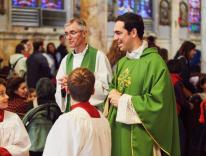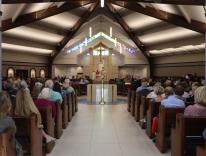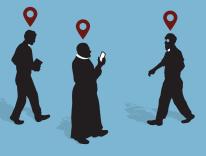RICHARD R. GAILLARDETZ
One of the fastest-growing ministries in the United States and Canada is the restored permanent diaconate. Not only have deacons mushroomed in number, so has their outreach. Some work as chaplains in jails and hospitals, others engage in catechetical ministry. Many preach and preside at baptisms, weddings, and funerals. Most assist liturgically at the celebration of the Sunday Eucharist. A growing number are serving as administrators for parishes without a resident priest/pastor.
Despite these remarkable developments, the role of the permanent deacon stands at a crossroads, for the very expansion of the various types of ministries in which deacons are now involved has run too far ahead of a developed theology of the diaconate. It is time for the church to take a closer look at the ministry of the deacon. Is the modern diaconate being transformed into a priestly auxiliary, a role that risks losing, or at least obscuring, the unique contributions the office can make to the life of the church?
The restoration of the permanent diaconate by Vatican II was an initial step toward dismantling the then-dominant view of permanent ministries as constituting a kind of ecclesiastical ladder. The life of the early church was rich with a great diversity of ministries. By the Middle Ages, however, these various ministries were seen no longer as vital to the life of the church but solely as stepping stones for hierarchical advancement. For example, a candidate for the priesthood in the Roman rite would have to move up the ecclesiastical ladder of porter, lector, exorcist, acolyte, subdeacon, and deacon before being ordained a presbyter. Many of these ancient ministries were reduced to nothing but a formality.
The restoration of the diaconate as a permanent ministry recalls a much more ancient tradition, a time when each of these ministries was valued for its own sake. “Promotion” was then a matter of the church’s recognizing that the gifts an individual exercised in a given ministry might justify his being called to a new ministry of ecclesial leadership. In the early centuries, bishops were frequently chosen from the ranks of the diaconate without first being ordained to the presbyterate. The full recovery of the ancient sense that each ordained ministry-deacon, priest, and bishop-possesses its own intrinsic meaning and value would be a wonderful asset for the church today. It could challenge deacons to see their ministry as a vital service to the church in its own right. It might even help inspire some priests to eschew careerist desires for the episcopate, and bishops to shun aspirations to be transferred to more prestigious sees.
A second contribution of Vatican II’s restoration of the permanent diaconate was the church’s recognition that celibacy need not be a condition for ordained ministry. By allowing married deacons-not as a dispensation from the law but as part of the permanent ordering of the community-the council rightly understood a distinction lost in the church’s current view of presbyteral and episcopal ministry, namely, the distinction between ministerial service to the church (am I called to ordained ministry in the church?) and the concrete manner in which one might live out the universal call to holiness (am I called to the single life, to the public witness to evangelical celibacy, or to the vowed life of marriage?). In its restoration of the permanent diaconate open to married persons, the council was saying that it is possible to respond to an ecclesial call to ordained ministry while fulfilling the universal call to holiness through the vowed life of marriage.
Beyond these two significant contributions, there have been other remarkable achievements. The number of men eager to enter programs requiring significant time and financial dedication, with little expectation of financial reward, has been a marvelous affirmation of the grass-roots vitality of the church. The fact that there are so many Catholics willing to come forward to serve the church, both as permanent deacons and as lay ecclesial ministers, should put to rest the argument that the paucity of vocations to the priesthood is due to a cultural narcissism in which people are simply unwilling to commit themselves to the church. Anyone who has been involved in the formation of candidates for ordination to the diaconate, as I was for ten years, cannot but be moved by such selfless dedication and commitment to the church.
Still, I fear the ministry of the deacon has gone beyond the role envisioned for it at the council and has lost its moorings in the tradition of diaconal ministry of the early church. By the middle of the second century, every church was led by an individual bishop. The bishop (in Greek, episkopos, meaning “overseer”) was so called because he exercised pastoral oversight over the local community. It was by virtue of his ministry as pastoral leader that he presided at the community’s Eucharist. In time, this ministry of oversight came to be extended to the priest/presbyter, who then also took on responsibility for presiding at the Eucharist. The basic insight was that whoever was the de facto pastoral leader of the community was the one who ought to preside over the liturgical life of the community.
Exercise of the diaconate in the early church took various forms. Deacons assisted liturgically at the altar, but they seldom, if ever, presided over the liturgical assembly. They proclaimed the word of God in the liturgy, though scholars disagree on whether they also preached. They participated in baptismal ministry within the context of a liturgy presided over by the bishop, but they did not preside at funerals. And since there was no public church ceremony connected with marriage, they did not preside at weddings. Finally, they did not serve as administrators over a church without a resident bishop or priest. Such a pastoral circumstance would have been inconceivable in the early church.
The primary ministry of deacons involved service to the bishop in administering the temporal goods of the local church, and in outreach to the poor and sick. Unfortunately, by the sixth century, the ministry of the deacon would be reduced from these once vital roles to little more than a steppingstone to priesthood.
Suffice it to say, diaconal ministry looks quite different today. In the absence of resident priests in many parishes in North America, deacons are being transformed into priests, j.g. (junior grade). As a result, there has been a growing emphasis on presiding over the liturgical life of the church and, in many cases, of exercising pastoral leadership in local parishes, a role not in keeping with the ancient tradition. Unlike priests and bishops, deacons are not ordained to pastor a community, and this fact should call into question the growing number of instances where deacons find themselves engaging in liturgical presidency (presiding over weddings, funerals, and baptisms).
In like manner, one must question the ecclesiological soundness of training deacons to administer parishes. Consider the following pastoral decision. A bishop needs to appoint an administrator for a parish that lacks a resident priest. He is presented with two candidates, a deacon and a lay person. There is nothing in the theology of the diaconate to lead the bishop to choose the deacon over the lay person. The determination of some bishops to put deacons in these positions may stem less from an ecclesiological conviction than from a sense of having greater canonical control over a deacon by virtue of his promise of obedience, clerical title, vestments, and the like. Still, while there may be a default preference for a cleric, there is no ecclesiological justification for it.
In light of these factors, if the permanent diaconate is to fulfill its promise, it must undergo significant reform: The church must address the present pastoral situation which tempts many bishops to expand the diaconate into ministries more proper to a priest, namely the current shortage of ordained priests. The present doctrinal and canonical restrictions regarding who may respond to a call to priestly ministry have led to fewer qualified candidates pursuing priestly ordination. Until a situation is created in which all who manifest a genuine charism for community leadership are doctrinally and canonically empowered to pursue ordination to priestly ministry, some will continue to look to deacons and others to serve as a stopgap.
In many ways, the next four proposals all depend on the church’s success in addressing this first issue. The church must consider imposing greater restrictions on the practice of deacons presiding over significant liturgical-sacramental events in the life of the church. These events should more properly be presided over by the true pastoral leader of the local community. If the deacon is the true pastoral leader of the community (the question of canonical restrictions aside), he ought to be ordained a priest. The same holds for the de facto lay leader of a local church. If presiding over baptisms and weddings presents a problematic exercise of forms of ministry more proper to the priest or bishop, there is nonetheless a good case to be made for expanding diaconal ministry to include the administration of the sacrament of the anointing of the sick. Associating the anointing of the sick with priestly ministry was a late historical development without much theological rationale. In the early church the practice soon emerged in which Christians took oil blessed by the bishop and stored it in their homes to administer to one another. In the fifth century we find a letter from Pope Innocent I specifying that the oil blessed by the bishop was to be used on the infirm in the community, whether administered by a priest, deacon, or lay person. Only when the sacrament of anointing became attached to the sacrament of reconciliation administered to the dying did anointing become exclusively identified with presbyteral ministry. Once it is untethered from the sacrament of reconciliation, it becomes difficult to argue against the appropriateness of deacons anointing the sick.
The restriction of ordained diaconal ministry to men ignores the testimony of tradition that women clergy engaged in public diaconal ministry in the early church (affirmed in Phyllis Zagano’s study of women deacons, Holy Saturday). The current prohibition of women from exercising diaconal ministry only perpetuates the sexist and clerical tendencies so evident in many spheres of church life. In her recent book, Sacramental Orders, Susan Wood suggests that the church phase out the transitional diaconate. It is a proposal with much merit. The transitional diaconate (the ordination to the diaconate of a candidate in preparation for priestly ordination) is a remnant of the medieval cursus honorum, when the diaconate was reduced to a steppingstone to priestly ordination. The present practice, where a seminarian is ordained to the diaconate approximately a year before his priestly ordination, has reduced the diaconate to a pastoral internship or field-education exercise. Recognizing that there is no solid ecclesiological reason for requiring ordination to the diaconate would go a long way toward the recovery of the diaconate as a permanent church ministry.
Deacons are ordained to stand before the community as living icons of Christ the servant. They are not ordained to pastoral and liturgical leadership of a community. They best fulfill their ministry when they give public witness to the Christ who healed the sick, embraced lepers, fed the hungry, and washed the feet of his disciples. In a church in which ordained ministry is so often associated with power and authority, the deacon is called to witness to the gospel demand that all exercises of power and authority be measured against the standard of Christ who came, not to be served, but to serve.
_____________________________________________________
THOMAS BAKER
The restored diaconate is still so new that we deacons are thrilled whenever anyone writes about us-even when, as in Richard Gaillardetz’s article, it ends up mostly being about what we shouldn’t be doing, rather than what we might.
My experience as a deacon for the past eight years confirms his news report: Many deacons are, in fact, serving as part-time de facto associate pastors, handling the baptisms, weddings, and parish meetings that associate priests used to and that solo pastors no longer can. Yes, in some cases, deacons are also taking some leadership roles that laypeople should have. Still, the reason you see so many deacons in parish liturgical and sacramental leadership isn’t clerical ambition; it is simply that the work needs to be done, parishes need the help, and deacons are often the only ordained ministers around to fill the gap.
It probably wasn’t supposed to turn out this way for deacons, even though one of the explicit reasons for restoring the permanent diaconate in the 1960s was to provide ordained people for places where priests were not available. The demographics of the priesthood are now a powerful force shaping the diaconate. So, frankly, is the unspoken reality that for the church, deacons are a bargain. The vast majority of us don’t draw any salary or benefits from our ministry at all, and those deacons retired from secular careers but working in a parish setting are doing so far below a living or market wage. Who can blame some bishops for looking to deacons first when there are parishes to fill?
For my part, though, I’m hoping this isn’t what it comes to - the diaconate as a way of backing into a married pastorate. I know some deacons who would be great pastors, but right now, at least, I don’t want the job. (One reason I’m still a Christian is that I’ve never had to work in a parish office.) Instead, I’m hoping there are some entirely new settings and assignments, outside the parish and the rectory, where bishops will start sending deacons, and where people will come to expect them.
Here, I’m not looking to Gaillardetz’s call for us deacons to be “living icons of Christ the servant.” I am well aware of the historical connection between deacons and service (diakonia), but to me, this is the kind of ambitious, heavily symbolic language about the ordained that hasn’t helped preserve the priesthood and won’t straighten out the diaconate, either. Either we’re all of us, all baptized Christians, called to be living icons of Christ the servant, or none of us is. I’m hoping for something a little less grand, and perhaps more concrete.
The key lies in the distinctive day-to-day reality and worldliness of deacons’ lives. To me, the great thing about being a deacon is that we are somewhere between the church and the world. We work in secular careers, not just for the church; we live in neighborhoods, not in a rectory. Somehow, our role must be to move back and forth among these spheres in some creative way. One ancient metaphor considers deacons to be “the bishop’s eyes and ears” - observing up close the needs and realities of the community and interpreting them for the church, and perhaps also interpreting the church and its hopes to the world. I’m more excited about that than I am about being an icon.
I’m not sure we’ve even begun to see the many ways in which this in-betweenness might emerge - and that’s partly because of the parish-centric way in which deacons are recruited and assigned. In spite of that, some deacons are being creative, developing unusual and innovative workplace ministries; others focus on community organizing, or on an approach to preaching that clearly reflects the reality of secular lives. The idea of “worker priests” didn’t quite work out - but “worker deacons” are now out there everywhere. Yes, laypeople are the principal ministers to transform the secular sphere. Still, I’d like to think deacons can help by bringing an ordained presence and identity to unusual places, and by bringing some elements of real life and speech into preaching and ministry.
That’s one rationale, I hope, for continuing to use deacons as parish liturgical ministers and sacramental presiders. I think it’d be a shame if, as Gaillardetz suggests, we were to put aside our work as baptizers, ministers of marriage, and homilists. If we’re doing it right, it should be a plus for the church, not a minus. Seeing the diaconate this way, as its own distinctive ministry and not a steppingstone to the priesthood or a make-do substitute, means there’s less justification (if there was any) for continuing to exclude women from it. I’m hoping to see things change. In the meantime, we have plenty of other issues with the diaconate to work out-but please, let’s allow it to be a bit of an experimental mess for a while longer. History, the new needs of the church, and the Spirit will ultimately shape it into what it needs to be, if we let them.
Please email comments to [email protected] and join the conversation on our Facebook page.
Share
Previous Story
‘Matrix' & other tricks
Next Story
Are the Bishops Listening?


